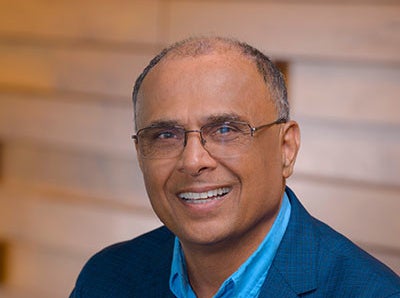
Raj Yavatkar is CTO of Juniper Networks, the networking solutions developer headquartered in Sunnyvale, California.
Yavatkar is responsible for charting Juniper’s technology strategy. He leads the company’s products in intelligent self-driving networks, security, mobile edge cloud, network virtualisation, packet-optical integration and hybrid cloud. In short, he’s the top tech dog at Juniper\.
In the latest Q&A in our weekly CTO Talk series, Yavatkar tells us why he believes self-driving cars are hyped up, the advice he’d give other CTOs and reveals how he ended up with Juniper Networks.
Robert Scammell: Tell us a bit about yourself – how did you end up in your current role?
Raj Yavatkar: I received my PhD specialising in computer networks. At Intel, I started as an Internet expert and drove the company’s new strategy and direction to help create a new product category called programmable network processors. Based on that work, I was appointed as a Fellow, the highest technical position, focused on driving the vision, strategy, and implementation for programmable network processors. I also spent time at VMWare and Google Cloud serving in technical roles. Currently, I am CTO of Juniper Networks, responsible for charting Juniper Networks’ technology strategy.
Where did your interest in tech come from?
My fascination for IT started with a transistor radio. I wanted to open it up and explore how it worked, but instead I went to a radio repair shop. There, I worked as an apprentice learning about voltage, potentiometers, etc., which led to the start of my interest in electronics. For undergrad, I studied electronics and telecommunications, and for postgrad, I studied computer science. At that time, computers were a big draw with their potential just beginning to be achieved in the context of building distributed systems to solve complex problems
Which emerging technology do you think holds the most promise once it matures?
Quantum cryptography. While quantum computing is already here, quantum computing applied to cryptography is going to change network security and truly secure data to prepare supply chains against attacks. When it comes to building chips, quantum cryptography will also allow us to provide line-rate cryptography in a way that’s really hard to penetrate and will secure key exchanges – even if exchanges are intercepted. We can also do key generation independently and still be able to meet in the middle, and that’s exciting.
How well do you really know your competitors?
Access the most comprehensive Company Profiles on the market, powered by GlobalData. Save hours of research. Gain competitive edge.

Thank you!
Your download email will arrive shortly
Not ready to buy yet? Download a free sample
We are confident about the unique quality of our Company Profiles. However, we want you to make the most beneficial decision for your business, so we offer a free sample that you can download by submitting the below form
By GlobalDataHow do you separate hype from genuine innovation?
Hype is something that tends to get a lot of attention early on. Autonomous cars are a good example. Another example was VR glasses almost 15 years back. The reality is that we are still a few years away from these things becoming a full reality.
With genuine innovation, it’s something that does not need hype but is evident by its immediate impact on changing how things are done. The first iPhone focused mainly on internet connectivity is a good example of such an innovation. Today smartphones come in many shapes and forms and are a part of critical infrastructure. It did not start with hype but with something that forced a paradigm shift about what a phone can do and how it can be used.
What one piece of advice would you offer to other CTOs?
The pace of innovation and transformation today is nothing like before. As CTOs, our role is to look at trends and pick out only those that are disruptive to our business or to other ecosystems where disruption can create new business opportunities. It is not sufficient to only evangelize existing products and look ahead at new generations, but also to invest in pathfinding and incubation. We have to test out ideas with minimum viable Proof of Concepts or prototypes to translate these disruptions into opportunities for our respective businesses. I advocate a more pragmatic approach as it forces you to find earlier milestones with real customer proof points. Having a vision is one thing, but your feet must be on the ground.
6) What’s the most surprising thing about your job?
In addition to looking at the technology landscape and making strategic bets on where the industry will go in 5-10 years, my job is very much about the human side of things as well, especially this past year during the pandemic. I make it a point to interact and talk to as many people as possible in my organization. We are a technology company but ultimately, it’s about the people that are making this possible. One of my passions is to help our engineers, product managers and others with career planning and development via mentoring, coaching and training in acquiring new skills.
What’s the biggest technological challenge facing humanity?
We are on the way to approach singularity when it comes to the advancement in AI/ML and application of these advancements in every aspect of business as well as human life. The challenge is balancing ethics of using AI/ML with the vast benefits it offers. It is crucial we figure this out before it is too late.
What’s the strangest thing you’ve ever done for fun?
One thing many do not know about me is that when I was an undergraduate, in support of flood victims in India, who were promised aid but never received it, I participated in a sit-in at the district magistrate’s office to show support. This stopped all the work there. We were detained for one night until the college Dean came to get us out.
What’s the most important thing happening in your field at the moment?
Technology is all around us today. It has changed how we live, work and play. However, not all technology is created equal. Juniper has always been focused on delivering highly performant, scalable, secure and reliable products with every inflexion of technology. What has changed is the focus has shifted to what experience you can deliver.
In another life you’d be?
An alpinist. I love adventure, especially hiking. I’ve hiked the Grand Canyon, Mount St. Helens, Mount Hood and others, but I really want to go to Kilimanjaro.








